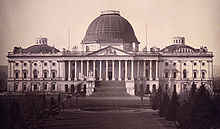27th United States Congress
| 27th United States Congress | |
|---|---|
|
26th ←
→ 28th
|
|

United States Capitol (1846)
|
|
| March 4, 1841 – March 4, 1843 | |
| Senate President |
John Tyler (W) until April 4, 1841 Vacant from April 4, 1841 |
| Senate Pres. pro tem |
William R. King (D) Samuel L. Southard (W) Willie P. Mangum (W) |
| House Speaker | John White (W) |
| Members | 52 Senators 242 Representatives 3 Non-voting members |
| Senate Majority | Whig |
| House Majority | Whig |
| Sessions | |
|
Special: March 4, 1841 – March 15, 1841 1st: May 31, 1841 – September 13, 1841 2nd: December 6, 1841 – August 31, 1842 3rd: December 5, 1842 – March 3, 1843 (lame duck) |
|
The Twenty-seventh United States Congress was a meeting of the legislative branch of the United States federal government, consisting of the United States Senate and the United States House of Representatives. It met in Washington, D.C. from March 4, 1841 to March 4, 1843, during the one-month administration of U.S. President William Henry Harrison and the first two years of the administration of his successor, John Tyler. The apportionment of seats in the House of Representatives was based on the Fifth Census of the United States in 1830. Both chambers had a Whig majority.
This list is arranged by chamber, then by state. Senators are listed in order of seniority, and Representatives are listed by district.
Senators were elected by the state legislatures every two years, with one-third beginning new six-year terms with each Congress. Preceding the names in the list below are Senate class numbers, which indicate the cycle of their election. In this Congress, Class 1 meant their term began in the last Congress, requiring reelection in 1844; Class 2 meant their term began with this Congress, requiring reelection in 1846; and Class 3 meant their term ended with this Congress, requiring reelection in 1842.
All representatives were elected statewide on a general ticket.
(5 Democrats)
(1 Democrat)
(6 Whigs)
(1 Whig)
All representatives were elected statewide on a general ticket.
(5 Whigs)
(2-1 Democratic)
(6-1 Whig)
(11-2 Whig)
(2-1 Whig)
(4-4 split)
The 4th district was a plural district with two representatives.
(6-2 Whig)
(10-1 Whig)
(1 Whig)
All representatives were elected statewide on a general ticket.
(2 Democrats)
...
Wikipedia
